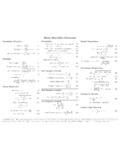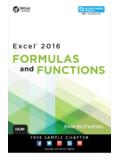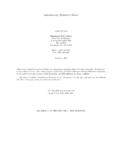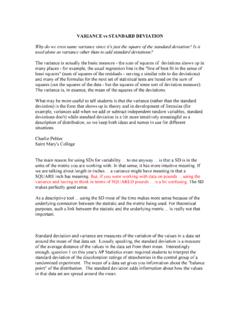Transcription of Formulas and Functions with Excel - CDTL
1 Centre for Development of Teaching and Learning (CDTL) National University of Singapore email: Formulas and Functions with Excel Kiruthika Ragupathi Assistant Director (Educational Technology) TABLE OF CONTENTS Introduction .. 4 Exploring the Excel Workspace .. 4 Navigating the Workbook .. 4 Setting up Data .. 6 Inserting a new column or row .. 6 Formatting the worksheet .. 6 Verifying Data .. 8 Formulas and Functions .. 8 Constructing a formula .. 8 Inserting a function .. 10 Built-in Functions .. 12 Mathematical Calculations .. 14 Conditional Calculations .. 17 Cutting up & Piecing together Text Strings using Text Functions .. 18 Using Look up tables / References .. 18 Pivot Tables .. 20 Create a PivotTable from worksheet data .. 21 Statistical Functions .. 22 Basic Statistical built-in Functions .
2 22 Linear regression Functions .. 23 Statistical Analysis .. 24 Using the Analysis ToolPak .. 25 Descriptive Statistics .. 26 More Information .. 28 3 Formulas and Functions with Excel Kiruthika Ragupathi, email: Centre for Development of Teaching and Learning Synopsis Need to perform complex calculations and data analysis? The usage of Formulas and Functions is what gives an Excel spreadsheet much of its power. This workshop explores the formula and Functions that are useful for computing and managing data. This course begins with mathematical principles and moves on to basic formula construction. Participants will learn about mathematical Functions , statistical Functions , conditional calculations, and lookup tables. In addition, the use of Analysis ToolPak will be discussed aiding in the generation of descriptive statistics and regression. Objectives By the end of this workshop, participants should be able to: Set up and verify data Understand the mathematical order of operations used by Excel Use the appropriate type of cell reference Construct basic Formulas Use statistical Functions Perform conditional calculations Use Analysis Toolpak 4 Formulas and Functions with Excel Kiruthika Ragupathi, email: Centre for Development of Teaching and Learning Introduction Microsoft Excel has many capabilities that make it suitable for use as a data management tool.
3 It provides multiple features for organising and managing data, so you can ensure that data is entered correctly and calculations and Formulas are valid. Data organisation features enable you to: sort and filter data, summarise and group data, and outline data so that you can focus on the key parts of your data. Validation features are very important for maintaining accurate records and to ensure that the data is correct, it is entered in the proper format, and Formulas are working correctly, Excel makes use of Formulas (mathematical expressions that you create) and Functions (mathematical expressions that are already available in Excel ) to dynamically calculate results from the data available in your worksheets. Exploring the Excel Workspace Let us start with an overview of the most important elements of the command area. 1. Use the File menu to open new or saved workbooks, save, print or close workbooks or manage Excel options.
4 2. You can set up a custom Quick Access toolbar on the upper left corner of the screen. You can place the most commonly used commands here. 3. The Ribbon is split into tabs where the commands are organised into logical groups. Each tab corresponds to the various toolbars used in the previous versions of Excel . 4. An Excel -help function as a question-mark icon on the outer right of the Ribbon. Navigating the Workbook This section explains how to navigate a spreadsheet to edit and format cells. The concepts can easily be applied to early versions of Excel ; menu locations may differ but commands are the same. The core document of Excel is a workbook. An Excel workbook can hold any number of sheets. Several worksheets can be saved together to form a workbook. The main types of sheets are: Work sheets Chart sheets At any one time, only one sheet is active in a workbook. Each spreadsheet is gridded into columns and rows.
5 Columns are denoted using letters, and rows are denoted by numbers. Cells are referenced by their column and row. For example, the cell in the upper left hand corner of the spreadsheet is called A1, for it is in column A and row 1. 5 Formulas and Functions with Excel Kiruthika Ragupathi, email: Centre for Development of Teaching and Learning Below is a picture of a blank workbook and descriptions of the more frequently used items. Creating a new workbook Start a new workbook by clicking the File menu and selecting New. In the New Workbook window, click Blank workbook. When you start Excel , a blank worksheet opens. Selecting cells Edit individual cells by clicking on them. Click a cell and drag the mouse pointer to select a range of cells. You can also select entire rows and columns by clicking on the number or letter heading of that alignment.
6 To select non-adjacent cells, hold down the CTRL key, and then click the cells that you want. Adding data manually To enter data manually into the spreadsheet, double click on the cell you want to edit. Notice that whatever you type appears in both the cell and the cell editor at the top. When you are finished typing, press Enter. Adding a new worksheet Click the Insert Worksheet tab at the bottom of the screen. To insert a new worksheet in front of an existing worksheet, select that worksheet and then, on the Home tab, in the Cells group, click Insert, and then click Insert Sheet. You can also right-click the tab of an existing worksheet, and then click Insert. On the General tab, click Worksheet, and then click OK. Insert Worksheet Home Ribbon Adjust appearance and data type Function Button Insert any of Excel s preset Functions into cells File Menu Open, start and save workbooks Columns & Rows Clicking column (vertical and row (horizontal identifiers will select the whole group formula Bar This area allows you to clearly edit individual cells Sheet Selection Tabs These allow you to switch between sheets in your workbook.))
7 You can rename, colour tabs an insert more worksheets 6 Formulas and Functions with Excel Kiruthika Ragupathi, email: Centre for Development of Teaching and Learning Renaming the worksheet Double-click the Name tab; when the default name is selected, type the new name. You can also right click on the Name Tab and choose Rename to type in the new name. Each worksheet can be colour-coded, as setting different colors is helpful when you have a large number of worksheets in a workbook. To set the color of the Worksheet tabs, right click on the tab and select a new color. Navigating To change the active cell, use the arrow keys, Page Up or Page Down keys, or use the mouse to click a new cell or drag the scroll bars. Embedding charts and pictures To create a new chart in Excel , on the Insert menu, from the Charts group, choose the chart type you prefer. To insert another file, such as a clip art, picture or a scanned image, from the Insert tab, under the Illustrations group, choose Picture or Clipart.
8 Setting up Data To use a spreadsheet efficiently, it helps to organise the data so that it is easy to read. When grading, columns are typically used for each assessment item, whereas rows are used for the individuals. The first row will be used for the column titles and the first column will be used for the serial number. You can use the second row to indicate the maximum possible score for each of the assessment item. Inserting a new column or row The process for inserting rows and columns is similar. To insert a column, click the header where you want to add a new column or row. On the header, right-click and in the drop-down context menu, select Insert. You may also use the Insert button to add new columns found in the Home tab, Cells group. When you insert a column or row, content found in columns will be moved to the right, and content in rows will be moved down.
9 Formatting the worksheet The formatting of a cell refers to both the way it is styled (stylistic formatting) and the way it Functions (numeric formatting). Formatting includes display characteristics such as font, size, alignment, style, color, as well as the type of data that the cell contains. For instance, a cell can be formatted to treat any data entered as a monetary amount and display only whole dollar amounts. Stylistic formatting options make your worksheet more attractive and easier to read. Appearance Formatting the appearance of cells, rows, and columns can be done with buttons in the Home ribbon or by right-clicking and choosing options from Format menu. To format cells, select the Home ribbon then select the column, row, group or the cells that you want to format. Then, select the formatting options you desire. 7 Formulas and Functions with Excel Kiruthika Ragupathi, email: Centre for Development of Teaching and Learning A new formatting concept called the document themes has been introduced in Excel 2007 and can be found in the Page Layout Tab.
10 These allow you to set many formatting options at once. Data Types The data type manages how Excel will display and interpret data in the cells. For instance, you may choose percentages as a fraction, decimal or whole number. It is important that Excel interprets your data correctly since Excel s Functions depend on the type of data being manipulated. After you type numbers in a cell, you can change the format in which they are displayed. The most commonly used data types for student data management in Excel are: Number: cells that contain only numerals, commas, and decimal points that can be used in numerical calculations. Click the cell that contains the numbers that you want to format. On the Home tab, in the Number group, point to General, and then click the format that you want. When you click on More Number Formats on the category list, the Format cells dialog box opens (similar to that in the older versions).





